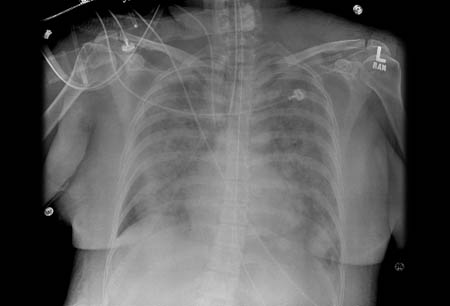Tests
1st tests to order
chest x-ray
Test
New onset of bilateral opacities that is not fully explained by effusions, lobar/lung collapse, or nodules is part of the clinical diagnostic criteria for ARDS.[1] Therefore, CXR is 100% sensitive.
Specificity is poor because other conditions may cause bilateral pulmonary infiltrates, including cardiogenic pulmonary edema and diffuse alveolar hemorrhage.[Figure caption and citation for the preceding image starts]: Chest x-ray image of bilateral infiltrates in a patient with ARDSFrom the personal collection of Dr Lorraine Ware; used with permission [Citation ends].
In resource-limited settings, lung ultrasound by an experienced operator to look for evidence of bilateral B lines and/or consolidations may be substituted if chest radiography is not available.[1]
Result
bilateral infiltrates
arterial blood gases
Test
A PaO₂/FiO₂ (inspired oxygen) ratio of ≤300 on PEEP or continuous positive airway pressure ≥5 cm H₂O is part of the diagnostic criteria for ARDS.[1]
It is 100% sensitive, but specificity is poor because many other conditions can cause hypoxemia.
Result
low partial oxygen pressure
sputum culture
Test
Sputum cultures are recommended to test for any possible underlying infection (as sepsis is the most common cause of ARDS).
Result
positive if underlying infection
blood culture
Test
Blood cultures are recommended to test for any possible underlying infection (as sepsis is the most common cause of ARDS).
Result
positive if underlying infection
urine culture
Test
A urine culture is recommended to test for any possible underlying infection (as sepsis is the most common cause of ARDS).
Result
positive if underlying infection
amylase and lipase
Test
Serum amylase and lipase, in conjunction with clinical assessment, can be used to help establish whether the patient has acute pancreatitis, a common cause of ARDS.[54]
[  ]
Both tests have similar sensitivity and specificity but lipase levels remain elevated for longer (up to 14 days after symptom onset vs. 5 days for amylase).[50] Its prolonged elevation creates a wider diagnostic window than amylase.
]
Both tests have similar sensitivity and specificity but lipase levels remain elevated for longer (up to 14 days after symptom onset vs. 5 days for amylase).[50] Its prolonged elevation creates a wider diagnostic window than amylase.
Result
amylase and/or lipase 3 times the upper limit of the normal range in cases of acute pancreatitis
Tests to consider
brain natriuretic peptide (BNP)
Test
BNP levels <100 picograms/mL make heart failure unlikely and thus ARDS more likely.
BNP levels >500 picograms/mL make heart failure likely and thus ARDS less likely.
BNP levels between 100 and 500 picograms/mL are indeterminate.
BNP levels may be difficult to interpret in patients with acute or chronic kidney failure. However, BNP levels should be <200 picograms/mL in patients without heart failure with an estimated glomerular filtration rate <60 mL/minute.
Result
BNP levels <100 picograms/mL
echocardiogram
Test
Abnormal left ventricular systolic or diastolic function suggests cardiogenic pulmonary edema rather than ARDS.
Some patients may have both ARDS and cardiac dysfunction.
Result
usually normal
pulmonary artery catheterization
Test
PAOP ≤18 mmHg suggests ARDS.
Pulmonary artery catheterization should not be used routinely to manage patients with ARDS.
Can be used to determine whether pulmonary edema is cardiogenic if the diagnosis is still in doubt after measuring brain natriuretic peptide levels and carrying out echocardiography.
Some patients can have an increased left ventricular end-diastolic pressure superimposed on ARDS. For this reason, PAOP measurements are no longer included in the definition of ARDS.[1]
In the ARDS Network FACTT trial, approximately 20% of patients had an initial PAOP >18 mmHg, although elevations >24 mmHg were unusual.[47]
Result
pulmonary artery occlusion pressure (PAOP) ≤18 mmHg
bronchoalveolar lavage or endotracheal aspirate
Test
Recommended in some patients with suspected pneumonia and patients without a defined predisposing condition, to exclude a noninfectious parenchymal lung disease.
Avoid in patients with suspected COVID-19-related ARDS.[49]
Result
identification of infectious pathogens; characteristic findings of alternative diagnoses
CT scan of the thorax
Test
CT scanning of the thorax is not routinely required to diagnose or manage ARDS. A CT scan provides more information than a plain CXR and may be helpful in some cases for diagnosing pneumonia or another underlying lung disease.
Result
may be helpful in identifying pulmonary causes of ARDS such as pneumonia
Lung ultrasound
Test
In resource-limited settings, lung ultrasound by an experienced operator may be substituted if chest radiography is not available.[1]
Result
May be helpful to look for evidence of bilateral B lines and/or consolidations
viral testing
Test
Reverse transcriptase-polymerase chain reaction or other molecular tests should be considered in the appropriate clinical setting (e.g., influenza, SARS-CoV-2).
Result
detection of SARS-CoV-2; may be positive for influenza A and B viruses and other respiratory pathogens
open lung biopsy
Use of this content is subject to our disclaimer